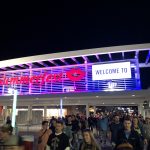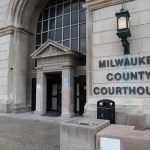Bridging the gap
Photo by Kat Jacobs
Pieter Godfrey and Ken Leinbach have more in common than first glance betrays. Pieter, in corduroy slacks and vintage frames, looks like someone who would refurbish warehouses and watch silent horror movies on the weekends. Ken is more of a jeans and hiking boots kind of guy; he looks like he’d be most comfortable helping kids identify unusual plant species out on the trails.
Pieter does like silent films, and Ken does teach little kids about nature’s awesome rarities. But Pieter and Ken – a restorations and reclamations professional and the executive director of the Urban Ecology Center, respectively – have forged an unlikely marriage of offbeat equals in the service of a common goal.
Together, Pieter and Ken are building a parking lot. And it may just be the noblest parking lot ever built.
A brief history of the Milwaukee River Corridor
The 5.5 mile stretch of the Milwaukee River that flows through the city proper was the most vibrant corridor of the city at the turn of the century. Dense with boathouses, swim clubs and biergartens, it was a year-round recreational Shangri-La: pleasure cruises in the summer, ice-skating and curling in the winter. But heavy traffic and rapid development in an industrial city led to pollution and, without a comprehensive sewage system, the river gradually became contaminated. Several large dams built to staunch floods collected runoff and waste and choked off surrounding ecosystems. The beaches and swim clubs were closed, the arch tunnels and stone bridges abandoned and the river corridor fell into ruin.
Starting in the 1970s, the city began to consolidate its sewer strategies, a multi-million dollar undertaking several decades in span. In 1986, Pieter Godfrey bought and refurbished his first warehouse when the river was still smelly and the surrounding park was still littered with the detritus of crime and drugs. Then in 1989, the Department of Natural Resources discovered a rare species of fish that spurred widespread discussion of the river’s devastated ecological condition.
In 1990, the North Avenue dam – the largest on the river – was removed. In 1991, the Urban Ecology Center was founded. Today, where there were once NO fish, there are at least 33 different species. The Urban Ecology Center features a green roof garden, the largest solar panel array in the state of Wisconsin and furnishings crafted from Pieter Godfrey’s salvaged wood. The UEC sees 30,000 students from 30 area schools a year and a total of more than 50,000 people.
In the city of Milwaukee alone, there are 794 acres of green space along this recovering river “that hardly anybody knows is there,” according to Ken. Pieter and Ken may be looking at this verdant stretch from different angles, but what they see is essentially the same.
“This is a tremendous asset for the city,” says Pieter, “and the reason it’s there is because nobody wanted it – because it was abused for so long.”
Parking: the great equalizer
The Park Place project is almost deceptive in its simplicity: a single-span bridge carrying two-way vehicular traffic to and from a 55-car parking lot on the west side of the Oak Leaf Trail. With booming neighborhoods, a large public high school and a growing university, parking around the UEC is already at a premium, and despite successful incentives for bikers to the Center, no one is naïve to the reality of the situation–destinations without parking have limited appeal.
The Milwaukee River is bluffed on both sides, which has made access to the river corridor difficult or impossible for people with mobility impairments. The parking lot will provide mobility-impaired visitors with access to the riverside, the trails and the wheelchair-accessible canoe launch and fishing pier planned as part of the greater riverside improvement project.
Broader access, the team hopes, will lead to broader awareness of the resources along the riverfront. And once the community recognizes the importance of the River and its potential, preservation and protection projects could domino further up the corridor.
“As development pressures occur,” Godfrey asserts, “communities have to work together.”
The collaborative nature of the Park Place project is precisely what makes it so promising. With participation from active nonprofits like the UEC, the Milwaukee Metropolitan Sewerage District and private land and business owners like Pieter Godfery, every interest is represented, checked and balanced and decisions made are “win-win for everyone.”
“Sometimes there’s pushing and pulling, sometimes we don’t get everything we want – the trick is to make the best of the partnership, so there’s no loss – so no one loses anything,” Pieter says.
Developers, for instance, are better served by an attractive recreational amenity than by a “condo canyon” along the riverfront. Businesses along the river, like Wisconsin Paperboard, have the opportunity to allow use of their land and donate their resources (Wisconsin Paperboard provides the UEC with many of its paper products) in exchange for a positive public profile. And everyone benefits from parks and trails that are clean and safe.
“It’s the great equalizer,” points out Ken. “Nature bridges gaps.”
The Park Place partnership and wider river preservation initiatives has been used as a model in cities from Baltimore to Bucharest. Recently, the mayor of Columbus, Ohio visited the UEC on a trip sponsored by The Limited, Inc.; now, the city is working on a $7 million dollar project to convert an abandoned industrial site into its own Urban Ecology hub.
“What we’re seeing is really a phenomenon,” Ken says.
“It’s more of a synergy than a phenomenon,” Pieter corrects, and then adds: “You can be as famous as you want. What really matters, what we’re really trying to do here, is to teach children to appreciate their environment, to respect it – and to respect themselves and their communities.
“If you don’t respect it, you abuse it,” Pieter agrees.
“And if it goes away,” Ken adds, “it will never be there again.” VS




















